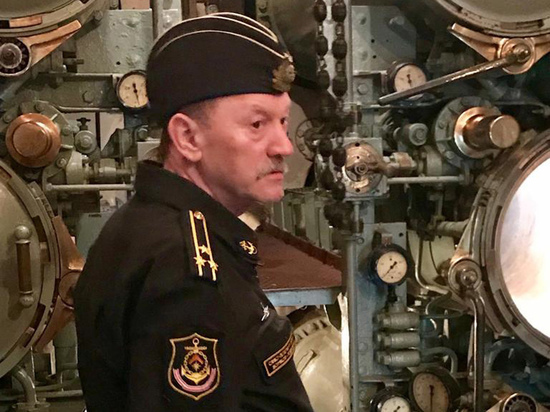“Materials on nuclear submarine accidents are usually classified for 25 years, will not wait long”
Experts continue to comment on the statement of the first commander of the Northern Fleet, Admiral Vyacheslav Popov, that the nuclear submarine K-141 “Kursk” was lost after a collision in the Barents Sea with a NATO submarine. The MK Chairman of the St. Petersburg Submarine Club, Captain of the 1st Rank Reserve Igor Kurdin, presented his version of the tragic events that took place on August 12, 2000.

Photo: vk.com/Igor Kurdin
– Today, November 22, Admiral Vyacheslav Alekseevich Popov is living to be 75 years old. Maybe it was an informational reason to talk to him. Although the reporter did not even congratulate him on his birthday and did not mention it. I listened intently to an hour-long conversation between Admiral Popov, who, of course, did not even ignore the sinking of the Kursk submarine. I want to say that many experts, including senior naval admirals, support Admiral Popov's version and believe that the main reason for Kursk's death was a collision with a foreign submarine. I would also like to draw attention to the very prompt statement of the Kremlin representative. Dmitry Peskov pointed to the fact that the investigation was carried out, a conclusion was drawn, so they do not consider it necessary to comment on the occurrence of any other hypotheses.
Igor Kurdin says that given the current military-political situation and the relations we have built with NATO, Admiral Popov's statement was very timely. Our country thus reminded Americans of old debts.
Kurdin has been conducting his own investigation for many years. Last year he published the book “Kursk. 20 years later. ” The 1st rank captain met and spoke to many people – the submarine designers, the shipbuilders who built it, the admirals and officers who prepared Kursk, including participating in these exercises, as well as the rescuers. .
– I draw attention to the opinion of rescuers, who immediately after the accident inspected not only the submarine lying on the ground, but also the entire adjacent area, – says Igor Kurdin, – They were given a clear task: to find evidence that there was a foreign submarine. They say they “dug the bottom through the nose” but found no evidence in favor of this version. Each of us can comment on any version, for example, there were more than 20 of them 20 years ago.
As a result, the government commissioner, led by the Attorney General, concluded that there was a man-made disaster. On the “Kursk” torpedo 65-76A exploded in torpedo No. 4 due to a leak of fuel components. The resulting fire resulted in the explosion of torpedoes located in the 1st Department. Two minutes later, a second explosion occurred, which destroyed several sections of the submarine.
Of course, I would not compromise on the version about the involvement of foreign submarines in the downing of Kursk. What I wrote about in the book. If Admiral Popov says he has evidence of foreign submarine involvement in the sinking of the Kursk, the main military prosecutor's office should be interested in them. But an investigation was still done. I repeat that the criminal proceedings I have do not contain any facts or evidence in favor of this version.
We know that Kursk was deep in the periscope on the day of his death, sailing at a constant course and speed for quite some time. It is absolutely true that foreign submarines could have watched him. That's why they were in this area. It may also be the fact that a foreign submarine could lose contact with Kursk, although this is unlikely. The ship sailing in the depths of the periscope is well intercepted. Well, let's say a foreign submarine has lost Kursk, what is it doing? He goes to the point of losing contact to restore it. In order to collide with Kursk, she had to be at the same depth or hit our submarine from below. However, experts who examined the Kursk hull before and after the ascent found no trace. Even during the explosion, some traces could be found, but they could not be found.
– The investigation concludes that there is no real confirmation of this fact. Or we don't know about it. The SOS signal is not just three dots, three dots, three dots. It is delivered via a special communication line on a specific international frequency that everyone can hear. The coordinates are entered automatically.
– The submarine project 667BDRM “Dolphin”, which I once commanded, also participated in these exercises, conducted rocket fire. At the same time, it was at a relatively large distance from Kursk. The submarine commander, my former assistant, told me that when they were 45 meters deep, they felt a strong water hammer at some point. He understood perfectly well that there could be no glaciers in the area at this time. No surface ship or vessel has such a draft to collide with a submarine. And they correctly assumed that they had encountered an alien submarine, which they reported. Then it turned out that their submarine was more than 80 kilometers from Kursk. This water hammer was from the second explosion, when the cruiser had already hit the ground.
I agree, if a foreign submarine hit Kursk, it would be several tens of meters from our cruiser. The impact on him would be like an explosion of a huge depth charge. And to say that it lay on the ground, and then the submarines managed to fix it, restore the course, it went on and our aviation found it in the Norwegian Sea, it kind of doesn't make sense.
Materials on nuclear submarine accidents are generally classified for a period of 25 years. We do not have to wait long, and quite possibly we will learn about some facts that suggest that we were wrong and that foreign nuclear submarines were indeed involved in the sinking of the Kursk.

